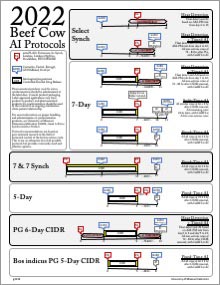
Editor’s note
The protocols described below are illustrated in the PDF, which is available via the “Download this publication” button.
Overview
Select Synch: This protocol requires heat detection and will require performing AI over multiple days. Note that heat detection needs to begin on the day prior to administration of PG. Because it does not involve a CIDR, this protocol has a lower overall pharmaceutical cost but is less effective in inducing cyclicity in anestrous cows. Because of this, Select Synch is not a commonly recommended protocol. It may, however, be a cost-effective option for producers who are very comfortable with heat detection and AI, have plenty of time and labor, and are managing herds in which the majority of cows are cycling prior to the start of the protocol.
7-Day: The 7-Day CO-Synch + CIDR protocol is one of the most commonly used protocols across the industry for fixed-time AI of beef cows. It is a simple protocol involving only two animal handling events before fixed-time AI is performed. If fixed-time AI is not feasible or desired, AI can be performed based on heat detection. Because this protocol has been found to be reasonably effective among both anestrous and cycling cows, it is a good option for typical cow groups when a minimal number of animal handlings is desired.
7 & 7 Synch: The 7 & 7 Synch protocol results in a greater proportion of cows exhibiting standing estrus as well as a significant increase in pregnancy rates to fixed-time AI in comparison with the 7-Day CO-Synch + CIDR protocol. The treatment schedule is similar to the 7-Day CO-Synch + CIDR protocol, but cows are handled one additional time, a week prior to GnRH administration. At the start of the protocol, a CIDR is inserted and PG is administered. This results in a greater proportion of cows ovulating in response to GnRH, ultimately improving uniformity among cows in stage of the estrous cycle at the end of the protocol. If maximum pregnancy rates to AI are desired and producers are willing to handle cows three times prior to fixed-time AI, this protocol is recommended. 7 & 7 Synch is also highly recommended if using sexed semen for fixed-time AI. If using sexed semen, consider applying estrus detection aids at the time of CIDR removal and PG administration on Day 14 in order to identify cows that are the best candidates to receive sexed semen.
5-Day: The 5-Day CO-Synch + CIDR protocol is similar to the 7-Day CO-Synch + CIDR but involves a shorter period of CIDR treatment. As a result, it requires administering two doses of PG approximately 8 hours apart. Because of the additional handling of cows and the additional pharmaceutical cost, the 5-Day protocol is a less commonly recommended protocol. However, research suggests a modest improvement in pregnancy rates to AI following the 5-Day CO-Synch + CIDR protocol in comparison with the 7-Day CO-Synch + CIDR protocol.
PG 6-Day CIDR: This protocol works very well for producers who are comfortable with heat detection and AI but also want the benefits associated with use of a CIDR. This protocol may also be used in heifers. Females expressing estrus and receiving AI from days 0 to 3 do not receive the subsequent GnRH, CIDR, or additional dose of PG. As a result, these costs are not incurred for all females. Although it does require more time and labor, the PG 6-Day CIDR protocol may be a good option for producers who are comfortable with heat detection and would like to avoid having large numbers of females to AI on any one day.
Bos indicus PG 5-Day CIDR: This protocol, also sometimes referred to as Bee-Synch II, has been found to be advantageous in Bos indicus and Bos indicus cross cows. This protocol is therefore recommended for producers with purebred Bos indicus (e.g., Brahman) or crosses of Bos indicus and Bos taurus (e.g., Brahman x Angus crosses, Brahman x Hereford crosses, etc.). Currently, it is unclear whether this protocol or other options should be preferred among Bos indicus-influenced cows when the percentage of Bos indicus-influence is very low. However, it is a simple protocol that has been effective in Bos indicus and Bos indicus cross cows, particularly in the southeastern United States.
2022 beef cow AI protocols
Pharmaceutical products used for estrus synchronization should be administered at the label dose. Consult product packaging. Label-approved applications vary from product to product, and pharmaceutical products for synchronization should be used in the context of an ongoing veterinarian-client-patient relationship.
For more information on proper handling and administration of synchronization products, see University of Missouri Extension publication G2022, Guide to Estrus Synchronization Products.
Protocol recommendations are based on peer-reviewed research in the field of hormonal control of the bovine estrous cycle. This is not an exhaustive list of all possible protocols but provides commonly-used and effective options.